On the apex predators list, we find many animals that dominate the ecological niche they’re in and are important for keeping prey populations down. Many of them got on the apex predators list because they have bright, colorful, or striking markings as a warning to prey animals of their danger. These markings also make them very beautiful, so determining the most stunning boils down to looking at the top apex predators of each type of animal.
Apex predators are famous for being successful hunters. They are fearsome because they are dangerous and have few to no predators.
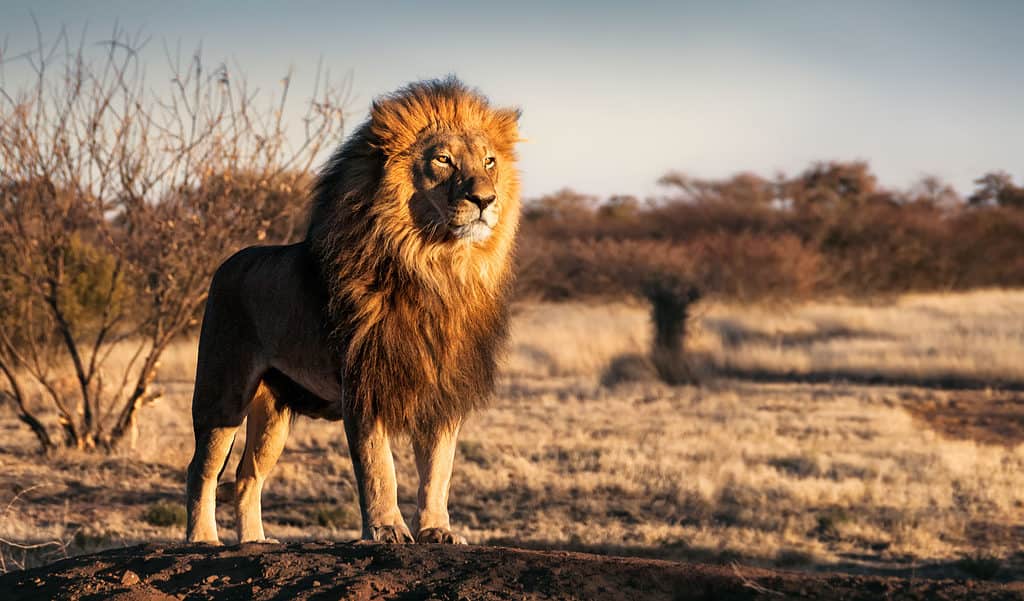
Apex predators are animals at the top of a food chain with no natural predators, like a lion.
©2021 Photography/Shutterstock.com
What Are Apex Predators?
Apex predators are animals at the top of a food chain that has no natural predators. They are typically large, powerful animals such as lions, sharks, crocodiles, and wolves, and play an important role in maintaining the balance of their ecosystem by controlling the population of prey species.
Apex predators are animals that sit at the top of the food chain and have no natural predators. They are typically large, powerful animals such as lions, sharks, crocodiles, and wolves, and play an important role in maintaining the balance of their ecosystem by controlling the population of prey species. They are often considered keystone species as they have a significant impact on the environment and other organisms in the ecosystem.
Apex predators are also known for their intelligence and hunting tactics. They often use stealth and patience to stalk and take down their prey. They also have specialized adaptations that help them survive and thrive in their environment. For example, sharks have sharp teeth and streamlined bodies for hunting in the ocean, while wolves have keen senses of smell and hearing for hunting on land.
However, many apex predators are facing threats such as habitat loss, hunting, and climate change which is causing their populations to decline. The loss of apex predators can have cascading effects on the entire ecosystem, leading to imbalances in the population of other species. Therefore, conservation efforts are needed to protect these species and preserve their important role in the ecosystem.
However, an apex predator can also look incredible while being at the top of the food chain. Below is a list of the world’s most stunning apex predators:

#10. Burmese Python
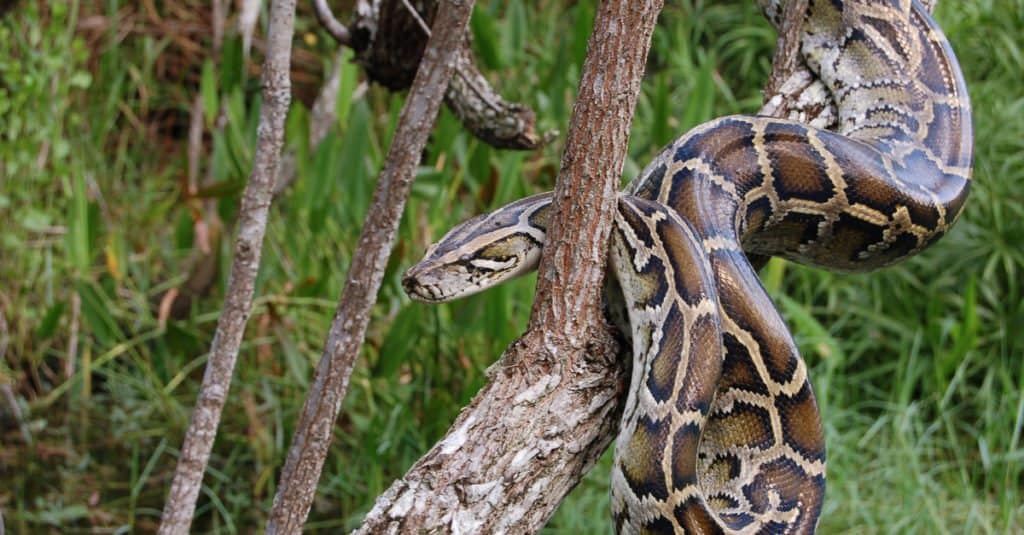
Burmese pythons are able to consume animals several times their size, including alligators and deer.
©Heiko Kiera/Shutterstock.com
Pythons, like constrictors, are primitive and don’t kill as venomous snakes do with biting and releasing venom. Instead, they use constriction, an ancient prey-killing method.
They are able to consume animals several times their size, including alligators and deer.
The Burmese python is the most beautiful of predatory snakes with its exotic coloring. It is also a testament to the possibility of invasive species becoming top apex predators, as is the case with escaped Burmese pythons in the Florida Everglades.
On the other hand, their population is decreasing in their native habitat of Southeast Asia.
Read here to learn more about Burmese pythons.
#9. Tiger

Tigers use their stalking skills, speed, and quick movements to take down their prey.
©iStock.com/Ondrej Prosicky
Big cats are top apex predators due to their large size, sharp teeth and claws, powerful bodies, and hunting skills.
When comparing the tiger against its cousin the lion, the tiger is heavier, larger, and longer than the king of the jungle. It’s also the biggest cat in the world and popular due to its exotic stripes and striking colors which enable it to camouflage itself.
When tigers hunt, they use their senses of sight and hearing to locate prey, then stalk the prey from behind in an effort to get as close as possible.
When they pounce, they will bite the animal’s neck or throat. Animals they prefer to eat weigh up to 45 pounds or more like deer, horses, cows, pigs, goats, moose, elephant and rhino calves, and tapirs.
A mysterious big cat, it’s a solitary creature that meets only during mating season.
While there were an original nine subspecies of tigers in the world, as of 2022 only six of these subspecies remain endangered.
The largest subspecies, the Siberian tiger, can weigh 660 pounds and be 11 feet long.
Read here to learn more about tigers.
#8. Bald Eagle
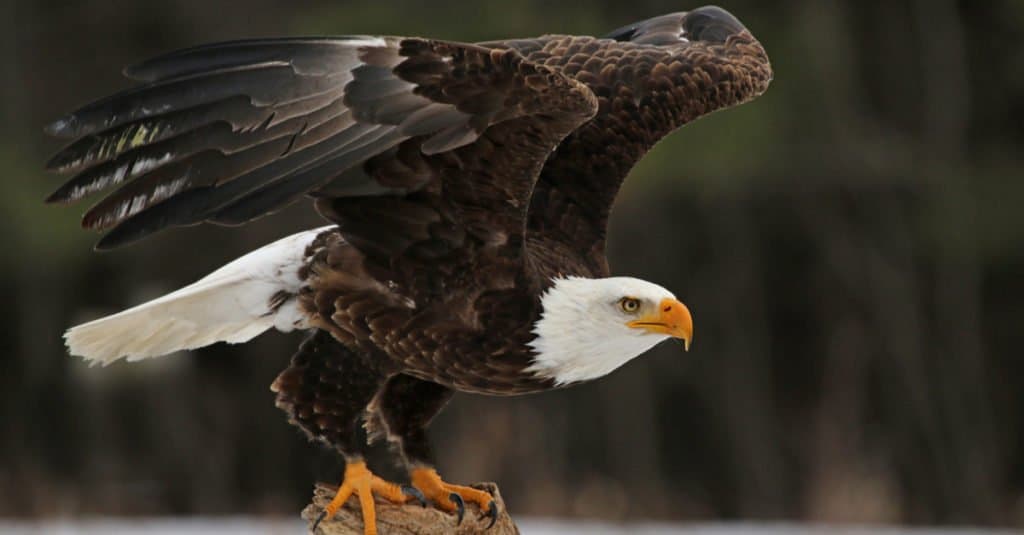
The grip of the bald eagle is 10 times stronger than that of a human, and it can carry up to four times its own body weight.
©Chris Hill/Shutterstock.com
The eagle is a national symbol for several countries, popular for its appearance representing beauty, freedom, and dignity.
As one of the top apex predators, the bald eagle is the largest raptor in North America. Conservation efforts brought it back from extinction by pesticides and hunting, with its population increasing and listed as Least Concern.
Living near bodies of water, it hunts fish, water birds, and small mammals, but also eats carrion and steals other birds’ prey.
It hunts by observing prey from a perch or the sky and swooping down to grab the prey with its razor-sharp talons.
Read here to learn more about bald eagles.
#7. Polar Bear

Polar bears can hunt on ice and in water and have been known to swim vast distances across the open ocean in search of food.
©Vaclav Sebek/Shutterstock.com
The adorable mascot of Coca-Cola is nonetheless one of the top apex predators. Its white fur enables it to camouflage itself while it waits by a crack in the ice for fish, seals, and other small mammals. It also scavenges carcasses.
The largest bear species and apex predator in the world, the polar bear can grow to 10 feet in length and weigh up to 1,500 pounds.
It lives in the arctic regions of Norway, Greenland, Canada, Alaska, and Russia, but is listed as Vulnerable due to habitat loss, hunting, pollution, and severe weather.
Read here to learn more about polar bears.
#6. Killer Whale (Orca)

Orcas use echolocation to hunt in the ocean, and they have no animal predators.
©slowmotiongli/Shutterstock.com
Although the killer whale (also known by its more benign-sounding name the orca) looks cute and magnificent to watch while it leaps in the water, don’t be fooled: It’s very deadly, attacking sharks, whales, and other large sea creatures and eating 100 pounds a day.
Belonging to the oceanic dolphin family, it’s a toothed whale that is present in all oceans, but data on its population is lacking.
It’s the fastest sea creature in the world with the ability to sail 30 miles per hour. Size-wise, it can grow up to 30 feet long and weigh up to 12,000 pounds or six tons.
It has a long lifespan too, with males living up to 60 years and females up to 80. Interestingly, its brain is five times larger than the human brain but is structured like one, making it one of the most intelligent sea creatures.
Read here to learn more about killer whales.
#5. Praying Mantis
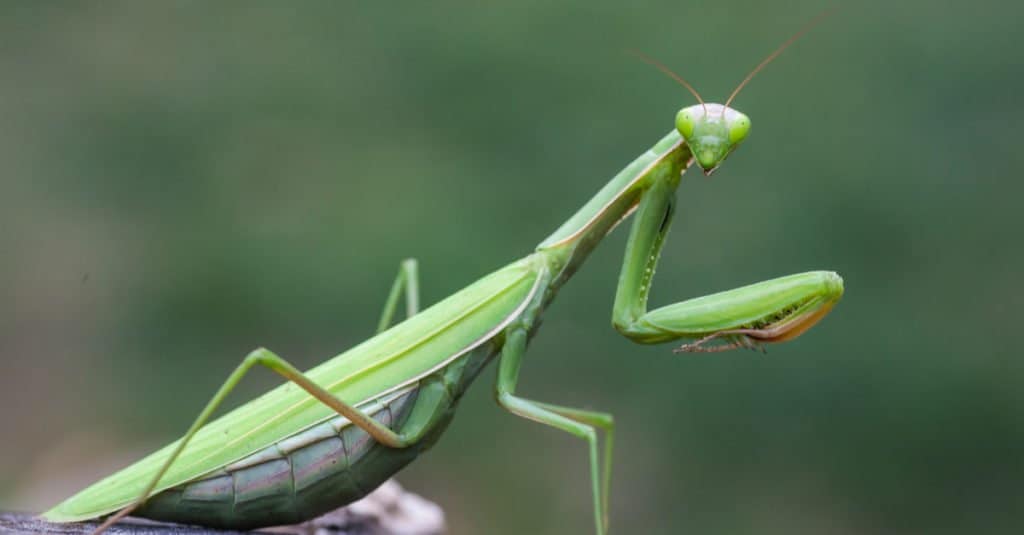
The praying mantis is known for its ability to grasp prey with its spiked forelegs.
©Ryzhkov Oleksandr/Shutterstock.com
At the top of the apex predator list for insects, the praying mantis is the most stunning. Not only was it named for looking like it’s praying, but it’s also brutal and can easily take down beetles, crickets, flies, bees, wasps, and even lizards and frogs with its spiny forelegs, lightning-fast speed, and voracious appetite.
Most praying mantis species are originally from the tropics and the mantids most often seen in the U.S. are exotic species. They have amazing vision and can turn their heads a full 180 degrees and they are also closely related to cockroaches and termites.
Although praying mantis species are normally harmless to humans; females have been known to consume their male counterparty. She may even decapitate her mate before they even engage in mating.
Although spiders are its main predator, the larger the mantis is, the most likely it is to escape webs. And it looks like it’s doing just fine, with its population listed as Least Concern.
#4. Black Widow

The black widow spider possesses a neurotoxin called latrotoxin, resulting in extreme pain and muscle rigidity in a victim.
©Jay Ondreicka/Shutterstock.com
Spiders in general are important apex predators which keep down pests. The black widow is the most stunning, featuring a black, bulbous body with a bright red hourglass-shaped mark on its abdomen.
The black widow spider has a deceptive size of one and a half inches, and its venom is 15 times deadlier than rattlesnake venom.
This makes it deadly for immunocompromised people, the elderly, and small children, as well as animals smaller than humans.
Achy muscles and nausea are the first symptoms, while the paralysis of the diaphragm causes respiratory difficulty. Another reason for its being one of the top apex predators is the fact that females sometimes kill and eat males after mating.
Read here to learn more about the black widow spider.
#3. Crocodile
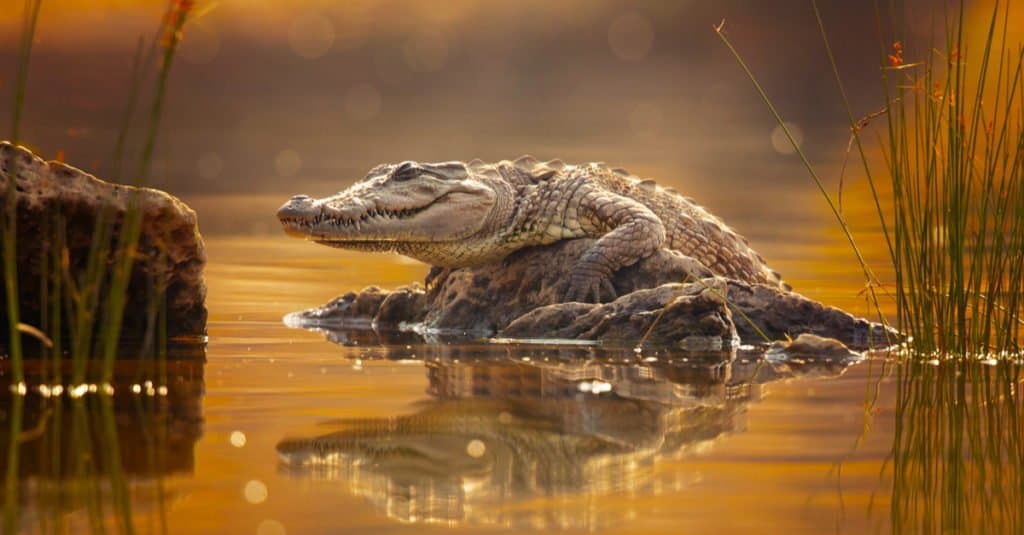
Crocodiles are one of the most well-known and fearsome animals in the world.
©Milan Zygmunt/Shutterstock.com
The saltwater crocodile is the largest crocodile and the largest living reptile around and is listed as Least Concern on the IUCN Red List. It is also likely to win in a fight against its cousin, the alligator.
Although females are much smaller, males grow up to 23 feet in length and weigh up to 2,200 pounds. The average adult crocodile’s teeth number 66 and have the greatest bite pressure of all animals, while its average lifespan is 70 years and over.
As a top apex predator, it attacks prey including crabs, birds, turtles, boar, monkeys, and buffalos, hunting by stealth in the water with only its eyes and nostrils showing.
It lives near the coasts of countries ranging from northern Australia, New Guinea, and Indonesia to the Philippines, Borneo, Sri Lanka, India, and Southeast Asia.
Read here to learn more about crocodiles.
#2. Komodo Dragon
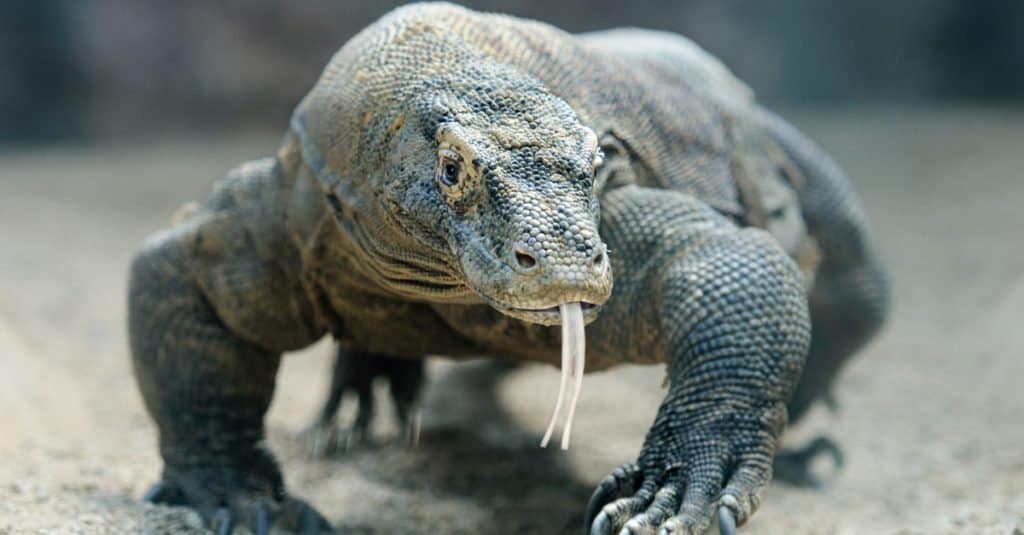
The Komodo dragon ambushes its victims with incredible speed and force.
©iStock.com/photomaru
The Komodo dragon is the largest living lizard on earth, measuring up to 10 feet in length and 200 to 360 pounds in weight. Boasting powerful legs and sharp teeth, it was a common belief for a long time that it killed with bacteria-filled saliva in its bite, but new research shows they actually kill with venom.
Native to Indonesia, it eats carrion but attacks large prey. Once it bites its prey and injects the venom, it pursues it until it succumbs to the effects.
It can eat 80 percent of its body weight in just a single feeding. While not necessarily fatal for humans, its bite can cause swelling, hypothermia, blood clotting, and paralysis.
Frequent fatalities from their attacks in their native Sunda islands of Indonesia inspired a “kill on sight” practice which made it vulnerable, and it has since been banned from being hunted.
Read here to learn more about komodo dragons.
#1. Wolf

The wolf is the top apex predator in the world.
©Jim Cumming/Shutterstock.com
The top apex predator in the world is the wolf, which was an easy choice. Hypnotic eyes, gorgeous fur, and a haunting howl make it jaw-droppingly astonishing for anyone fortunate enough to catch a glimpse of one.
This pack animal lives and hunts in a pack of anywhere from two to 15 wolves or more members led by an alpha male and alpha female, making it especially powerful in numbers. An adult wolf needs to eat about 5-7 pounds of meat every day to maintain a healthy weight. Typically, a pack will kill a single large mammal and survive off the meat for several days before moving on to the next opportunity. The average wolf eats the equivalent of 15 deer across an entire year.
The population of the type species the grey wolf is stable and listed as Least Concern.
Read here to learn more about wolves.
Here are Three More Beautiful Apex Predators
Our list of beautiful apex predators is a good one – but there are a few more contenders that deserve an honorable mention. None of these animals will win in the congeniality category – but their stunning beauty can not be denied.
Snow Leopard
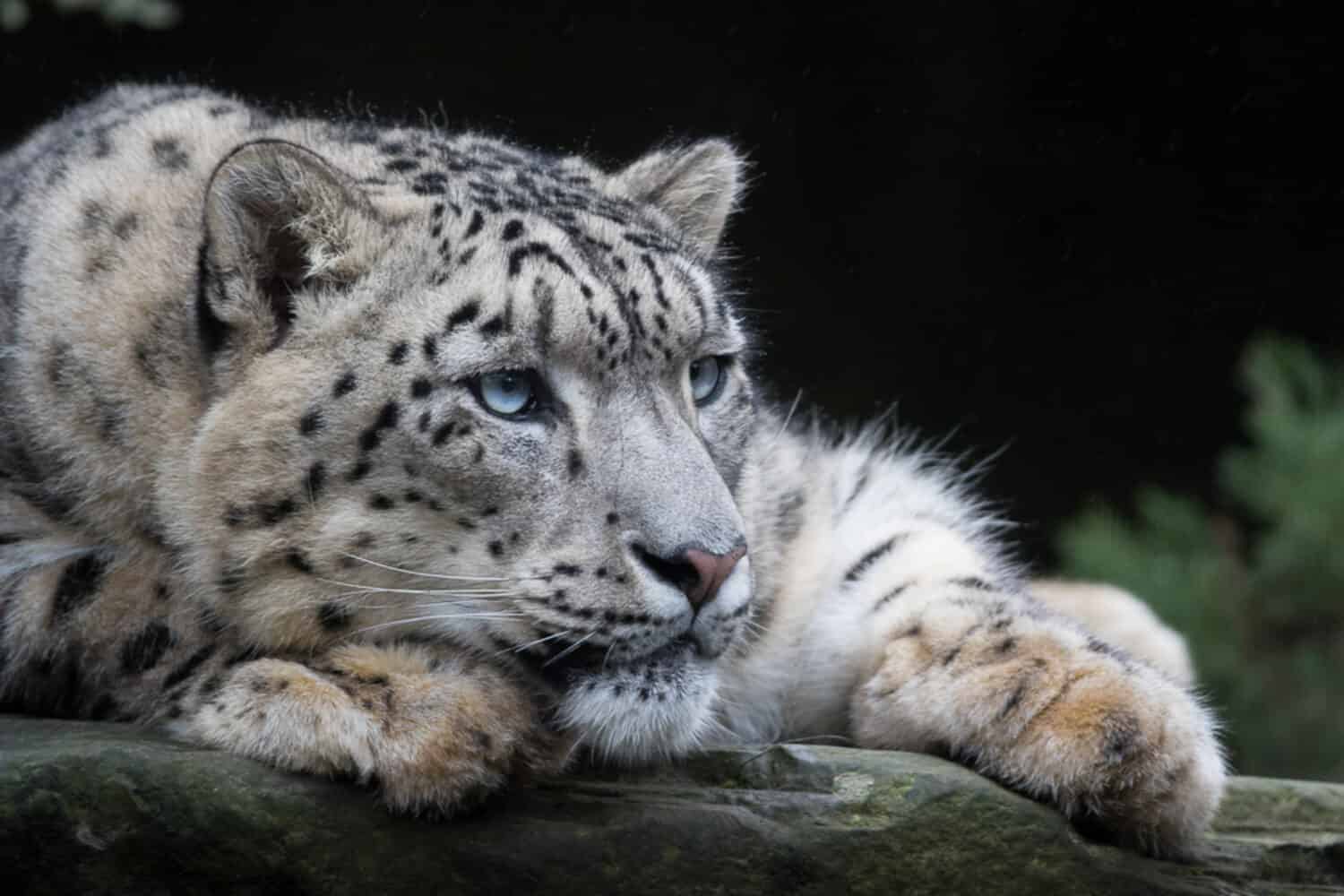
The snow leopard’s plush, silky coat is strikingly beautiful.
Image: Andywak, Shutterstock
©Andywak/Shutterstock.com
In the world of wild cats – the Siberian Tiger comes to mind when considering beauty, but let us consider the elusive snow leopard. The adaptations this cat has made to survive life in cold, mountainous environments have only enhanced its beauty. The snow leopard’s plush coat – several layers thick – protects it from frigid temperatures with style. Its silky fur actually glistens in the light of the sun – the gray hues and subtle spots are understated – reflecting the cat’s desire to stay out of the spotlight.
The snow leopard’s broad feet are covered in soft fur all the way around – even on the bottom to improve their grip on steep surfaces. Their impressive size distributes the animal’s weight efficiently when walking on snow – and may be the most gorgeous paws on the planet. The fierce cat’s tail is extra-long and bushy – so decadently soft and thick that it is used like a blanket to protect its face as it sleeps.
The beautiful face of the snow leopard is rarely seen in the Far East mountains where it resides – as it prefers to remain solitary. The apex predator of the snowy Tibetan peaks only offers an occasional glimpse of its stunning beauty.
Snowy Owl

The
snowy owl
is the only owl with mainly white plumage.
©Bruno De Faveri/Shutterstock.com
Here is another example of an apex predator whose cold weather adaptations have enhanced its beauty. The snowy owl, native to the Arctic regions of North America and the Palearctic regions, is the only owl with mainly white plumage. These stunning birds of prey are so white that when seen from a distance they appear to be a lump of snow on the ground. They are covered in subtle spots and markings – with pure white faces, chests, feet, and underwings. Snowy owls possess the longest toe feathers of any owl – cloaking their deadly talons in a fluffy, soft disguise.
The owl’s piercing yellow eyes allow it to spy on its prey in darkness while enhancing the appearance of the animal. The striking contrast of the eyes to the soft white face of the owl may be nature’s way of warning admirers not to fall prey to its terrible beauty.
Jaguars
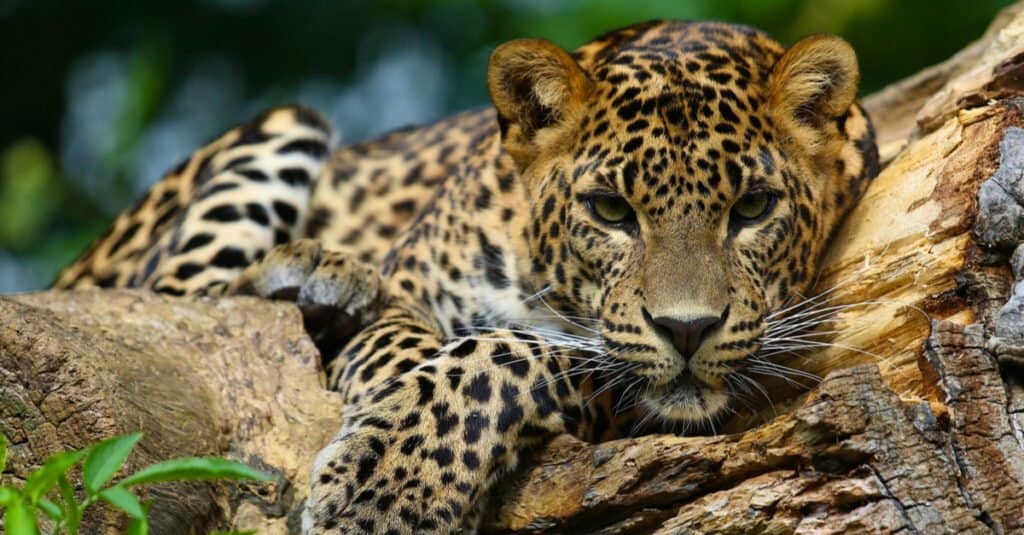
The
jaguar
possesses such a powerful bite, it can pierce the shell of turtles and tortoises.
©L-N/Shutterstock.com
Let us dust off the snow and head into the tropical rainforests of Central and South America, where the undisputed apex predator reigns over the jungle clad in classic leopard print. The jaguar is afraid of nothing – not even humans – and it wears its crown with the ease of a creature secure in its status as one of the most deadly killing machines on earth. Its yellow-brown spotted coat blends into the dense jungle as seamlessly as the snow leopard’s white coat in a swirling snowstorm.
The jaguar is one of the biggest cats – weighing up to 250 pounds and wielding one of the most powerful bite forces in the world – capable of crushing skulls in one horrifying bite. Unlike its African cousins – the jaguar doesn’t suffocate its prey by choking its windpipe – it simply cracks their skulls in its massive jaws. The jaguar is as undeniably beautiful as it is terrifying.
Summary of the 10 Most Stunning Apex Predators
Here is a review of the apex predators that we have found to be the most stunning in the world:
| Rank | Apex Predator |
|---|---|
| 1 | Wolf |
| 2 | Komodo Dragon |
| 3 | Crocodile |
| 4 | Black Widow |
| 5 | Praying Mantis |
| 6 | Killer Whale (Orca) |
| 7 | Polar Bear |
| 8 | Bald Eagle |
| 9 | Tiger |
| 10 | Burmese Python |
The photo featured at the top of this post is © iStock.com/Ondrej Prosicky
Thank you for reading! Have some feedback for us? Contact the AZ Animals editorial team.






